Servicios Personalizados
Articulo
Indicadores
Links relacionados
-
 Citado por Google
Citado por Google -
 Similares en Google
Similares en Google
Compartir
South African Journal of Science
versión On-line ISSN 1996-7489
versión impresa ISSN 0038-2353
S. Afr. j. sci. vol.119 no.9-10 Pretoria sep./oct. 2023
http://dx.doi.org/10.17159/sajs.2023/15001
RESEARCH ARTICLE
Assessing the adoption of improved seeds as a coping strategy to climate variability under smallholder farming conditions in South Africa
Lindumusa MyeniI; Mokhele E. MoeletsiI, II
IAgricultural Research Council -Natural Resources and Engineering, Pretoria, South Africa
IIRisks and Vulnerability Assessment Centre, University of Limpopo, Sovenga, South Africa
ABSTRACT
This study was undertaken to examine the adoption rate, constraints and factors determining the uptake of improved seed varieties in smallholder farming conditions of South Africa, using a maize crop. Primary data were collected from 279 smallholder farmers in the Maluti-a-Phofung municipality of the Free State Province using a household questionnaire and were validated through focus group discussions with key local informants. Descriptive statistics, frequency analysis and a binary logistic model were used for data analysis. Results show that the majority of the farmers (>69%) were growing uncertified local seed varieties saved from their previous harvest or acquired from neighbouring farmers. The lack of awareness and knowledge of, inadequate information, unaffordability and unavailability of improved seeds, low income and landlessness were major constraints limiting the adoption rate. Age and income were the main variables that had a positive and significant effect on the adoption of improved seed varieties, whilst ownership of livestock had a significant and negative influence on their adoption. As a result, the promotion of improved seed varieties needs to be supported by conducive and effectual institutional policies that will improve the provision of extension services, capacity-building initiatives, subsidy programmes, financial resources and good agricultural lands, and reduce the transaction costs of improved seed varieties. The recommendations from this study can be used by the government and other developmental organisations to enhance the wider uptake and use of improved seed varieties in smallholder farming conditions not only in the study area but also in other regions with similar challenges.
SIGNIFICANCE:
• A lack of awareness and knowledge of, inadequate information, unaffordability and unavailability of improved seeds, low income and landlessness are key constraints limiting adoption.
• We recommend the provision of knowledge and awareness-raising of improved seed varieties through enhanced extension services and capacity-building initiatives as key strategies to improve the adoption rate.
• The recommendations of this study can be used to enhance the wider uptake and use of improved seeds and assist smallholder farmers to cope effectively with climate variability and change.
Keywords: climate-related risks, climate-resilient seeds, climate-smart agriculture, farmers' seed systems, maize seed varieties
Introduction
Agriculture, particularly rainfed crop production, is extremely susceptible to the impacts of climate change.1 The changing rainfall patterns (i.e. rainfall onsets and amounts), elevated air temperatures and increase in the incidents of weather-related risks such as droughts, floods, frost, and crop diseases and pests attributed to climate change are a serious threat to agricultural production and food security.1-3 These weather-related risks are expected to increase in both frequency and magnitude and may push 122 million more people into extreme poverty by the year 2030.4 African smallholder farmers are amongst the most vulnerable as a result of their high dependence on rainfed crop production and they have limited adaptation capacity due to the lack of knowledge or skills, limited resources and financial constraints.1,5,6 There is an urgent need for the development and implementation of effectual adaptation and mitigation strategies to combat the negative effects of climate variability on crop production and contribute towards the achievement of the Sustainable Development Goals.7,8
Climate-smart agriculture (CSA) is a viable approach to sustainably increase productivity and improve the climate resilience of smallholder farmers whilst at the same time reducing agriculture's contribution to environmental contamination and climate change.9,10 The use of improved seeds, particularly climate-resilient varieties, is one of the most important and effective CSA strategies to improve crop production and enhance climate resilience in smallholder farming conditions.7,11,12 Some of these improved seed varieties possess desirable traits such as drought and heat tolerance, early maturing, high yielding, pest and disease resistance, better milling or cooking quality, better nutritional content and better nitrogen-use efficiency.13-16 Depending on local context, exposure and vulnerability, these traits can help smallholder farmers in the mitigation of abiotic and biotic stresses that are prevailing in the specific region.1,17,18
The planting of locally adapted seed varieties of good quality at the right time whilst using sustainable agricultural practices and the recommended application rates of other inputs provides healthy crop establishment and subsequently good crop yields.13,19 23 Furthermore, the use of high-quality seeds also ensures the efficient use of other inputs such as labour, fertilisers and pesticides in farming systems.24 Several other crop management strategies to cope with climate change, such as changing seed densities or seed rates and changing crop varieties and association, all depend on the stable availability and affordability of good-quality seeds. Furthermore, research has shown that improved seed varieties performed significantly better than local seed varieties over a wide range of agro-climatic conditions, under both optimum and stress growing conditions in Africa.18,23,25-27 Moreover, empirical studies in different African countries have shown that the adoption of improved seed varieties increases yields, yield stability, food security and profitability and reduces poverty in smallholder farming conditions.12,14,18,28
Despite substantial efforts in research on the development and promotion of improved seed varieties as part of the Green Revolution initiative29, the wider uptake and use of improved seed varieties by smallholder farmers is still low and unsatisfactory in Africa16,17,26,30. Thus, most African smallholder farmers plant local or indigenous varieties (landraces) that produce lower yields and are often most vulnerable to abiotic and biotic stresses, regardless of numerous improved seed varieties that are commercially available.14,31 Consequently, crop yields of smallholder farmers remain very low and stagnant despite the proliferation of input subsidy programmes of the national governments and developmental agencies in Africa.17,27 For example, the Agricultural Research Council (South Africa) has been involved in projects such as the Water Efficient Maize for Africa (WEMA) and Improved Maize for African Soils (IMAS) aimed to develop, test and disseminate improved maize varieties to improve yields and food security under the threat of climate variability in smallholder farming conditions.32 However, the low adoption of improved seeds by smallholder farmers is a serious concern of the government and other development organisations as climate change is already and anticipated to continue exposing the most vulnerable communities to food and nutrient insecurities, poverty, economic crisis, environmental and ecosystem degradation and health issues.33,34
The understanding of the main challenges limiting the wider uptake and use of improved seed varieties by smallholder farmers is critical for the development and implementation of effectual policies, programmes and initiatives aimed at improving crop production, food security and climate resilience in smallholder farming conditions with greater potential in climate mitigation.5,8,35,36 Previous studies have indicated that restricted availability of improved seed varieties, high prices of seeds, risk aversion, preference for local varieties, low income, lack of knowledge and credits are amongst the major constraints limiting smallholder farmers from adopting improved seed varieties.1,13,17,19,37 This previous research showed that the key barriers and determinants of adoption of improved seed varieties are local-specific due to the differences in local seed systems, institutions, policies, political and cultural ideologies, availability of resources and infrastructure.1,35
Few studies have investigated the factors influencing the adoption of improved seed varieties in South Africa.21,28,36,38 Thus, the understanding of key barriers and determinants for the adoption of improved seed varieties is limited in South Africa, particularly in smallholder farming conditions. Given that South Africa has one of the most established and competitive seed sectors in Africa39,40, the understanding of barriers and determinants for the adoption of improved seed varieties could give new and deep insights into factors to be considered when promoting improved seed varieties in smallholder farming conditions. Therefore, the present study aims to identify the key barriers and determinants of the adoption of improved seed varieties in the Maluti-a-Phofung municipality of the Free State Province of South Africa. The present study only focuses on the maize (Zea mays L.) crop, one of the main staple foods in the southern African region.31,41
In the present study, firstly we determined the adoption rate of improved maize seed varieties; secondly, we identified the constraints associated with the adoption of improved maize seed varieties; and thirdly, we investigated the factors influencing the adoption of improved maize seed varieties. Lastly, we recommend pertinent approaches and pathways to increase the use of improved maize seed varieties in the study area.
Materials and methods
Study site description
This study was conducted in diverse villages surrounding Harrismith and Phuthaditjhaba towns of the Maluti-a-Phofung municipality in the Thabo Mofutsanyana district of the Free State province of South Africa (Figure 1). The Free State is a summer rainfall region that contributes over 30% of the total maize production of the country, mostly under rainfed cropping systems.42-45 This region has a subtropical highland climate with mean annual precipitation ranging between 500 and 900 mm and a mean annual air temperature of 17 °C.44 There is high spatial rainfall variability in this region due to orographic patterns.42,43,45

The recent increase in the incidents of droughts, frost, hailstorms, and crop pests and diseases are the major weather-related risks affecting agricultural production in this region.42-44 Therefore, the wider uptake and use of improved seed varieties, particularly climate-resilient varieties that possess desirable traits such as drought and heat tolerance, early maturing, high yielding, disease and pest resistance is expected to improve crop production and enhance climate resilience in this region.
Data collection
The study relies on survey data gathered by the ARC as part of the InnovAfrica project (www.innovafrica.eu). This 4-year international collaborative project was initiated in 2017 with the aim of improving the food and nutritional security of African smallholders in six countries, including South Africa.46 Detailed information about the activities of the InnovAfrica project in the South African case study was presented by Myeni et al.33 Primary data were collected using a pre-tested, structured household questionnaire following a systematic random sampling technique whilst deliberately targeting smallholder farmers. Details of the procedures undertaken during the household survey were presented by Myeni et al.5,8 Ethical clearance to conduct the study was provided by the Ethical Clearance Committee of the Agricultural Research Council -Natural Resources and Engineering. Data collected from a total of 600 smallholder farmers through the household questionnaire were compiled in a Microsoft Excel spreadsheet and underwent a data quality process to detect and eliminate incomplete, erroneous and suspicious data. Data on the potential pathways to improve the use of improved seed varieties within the context of climate change adaptation were collected through participatory engagements with multiple local stakeholders such as beneficiary farmers, extension officers, farmer associations, agro-dealers and traditional leadership during focus group discussions. Furthermore, these focus group discussions were used for the validation of the data collected through the household survey. After the data quality process, a total of 279 questionnaires that had good-quality data were reserved for further data analysis using the Statistical Package for the Social Sciences (SPSS) version 23.0. Details of the procedures undertaken during data analysis are presented in Section 1 of the supplementary material.
Results and discussion
The descriptive analysis of the demographic characteristics of household heads in the study area is presented in Section 2 of the supplementary material.
Types and sources of seeds grown
The results indicate that the majority of smallholder farmers grow local seed varieties (76%) whilst only about 14% grow improved seed varieties, thereby suggesting a very low level of adoption and use of improved seed varieties in the study area (Table 1). The results also show that about 10% of the farmers grow unknown seed varieties. These findings indicate that some of the farmers plant any seed varieties that are accessible and available to them without any prior knowledge of their specific characteristics and traits.
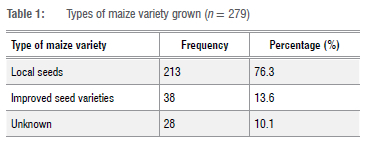
The majority of the smallholder farmers planted uncertified seeds either from their own farm (41%) or acquired from other farmers (28%), whilst about 30% purchased their seeds from cooperatives and private traders (Table 2). These findings indicate that the informal farmers' seed system was the main source of seeds grown by smallholder farmers (>69%) despite its low yield potential, as also reported by previous African studies.14,19 33 Generally, the seeds are old varieties that have been circulating for decades and they vary from poor to fair in quality.
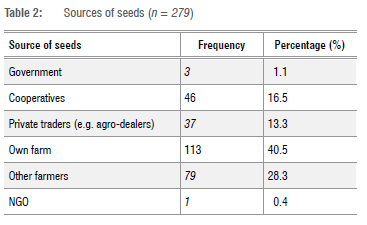
Determinants to the adoption of improved seed varieties
The results show that the adoption of improved seed varieties was driven mostly by factors such as easy and stable access to seeds (32%), high yield (29%), taste (14%) and multi-purpose (12%) (Table 3). These findings indicate that it is important to consider the farmers' preferences when selecting and promoting particular improved seed varieties in the study area. Remarkably, drought tolerance (8%), early maturation (5%) and tolerance to pests and diseases (0.4%) were the least reasons stimulating the farmers to adopt improved varieties. This suggests that most of the farmers lacked knowledge and information regarding seed varieties, their attributes, as well as their critical roles in combating the effects of climate variability. The focus group discussions revealed that most of the farmers plant local seeds mainly because this variety has easy and stable accessibility for free or at a low cost.
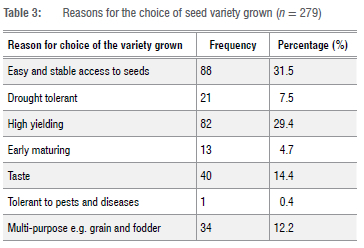
Constraints to adoption of improved seed varieties
The results indicate that most of the farmers (76%) perceived no quality problems with their seeds (Table 4). The focus group discussions revealed that most farmers were mostly unaware of the quality indicators used to define good-quality seeds and their estimations of quality were only based on the physical appearance of the seeds. At least 15% of farmers indicated that a low germination rate was one of the quality-related challenges being observed in their seeds whilst only 6% of respondents indicated that unhealthy seeds were the key constraint.
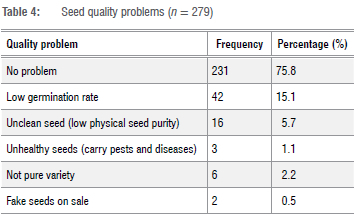
The majority of the farmers (29%) perceived that they had not experienced any non-availability of improved maize seeds in the study area (Table 5). Furthermore, the results indicate that a limited number of suppliers (21%), poor road infrastructure (17%), limited quantity available from the supplier (14%), long distance to the supplier (11%) and unsuitable package size (7%) were the major reasons limiting the availability of improved seeds in the study area. This suggests that although improved seed varieties are readily available from the formal market, the high transaction cost of improved seed varieties attributed to the long distances to the suppliers, the limited number of suppliers, poor road infrastructure and unsuitable package size were the major constraints limiting the adoption of improved seed varieties in the study area. Our findings are in agreement with previous studies that have reported similar constraints to the utilisation of improved seeds by smallholder farmers.47,48
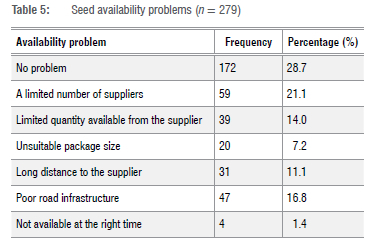
The majority of the farmers (58%) perceived that seeds were accessible without any challenges (Table 6). This is probably because most of them use seeds that are saved from the previous harvest or acquired from neighbouring farmers. Furthermore, the results indicate that limited purchasing power (23%), ineligibility for support or subsidy (11%) and limited access to social networks (7%) were the major challenges faced in accessing improved seed varieties in the study area. This suggests that although improved seed varieties are readily available from the formal market, the farmers cannot afford to purchase them due to financial constraints. Similar findings have been reported in previous studies where the cost of improved seed varieties has been identified as one of the key constraints to the adoption of improved seed varieties by African smallholder farmers.1,36,49
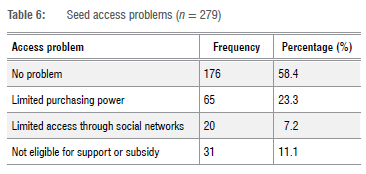
Factors influencing the adoption of improved seed varieties by smallholder farmers
Characteristics of adopters and non-adopters of improved seed varieties
The results show significant mean differences between adopters and non-adopters only regarding gender, income and land, whilst the other differences were marginal (Table 7). The results suggest that male farmers were more likely to adopt improved seed varieties at a 10% significance level due to their higher chances of accessing new information, agricultural resources and financial resources compared to their female counterparts. Our findings are similar to previous studies that postulated that male farmers were more likely to adopt improved seed varieties.35,36 Off-farm and on-farm income for adopters was significantly larger than that of non-adopters at a 1% level, thereby suggesting that farmers with higher incomes were more likely to adopt improved seed varieties than poor farmers, also reported by.17,36 The results indicate that the majority of adopters owned more land than the non-adopters, suggesting that farmers who owned land were more likely to adopt improved seeds at a 10% level. The results also reveal that the average farm size for adopters was significantly larger than that of non-adopters at a 5% level, thereby suggesting that farmers with larger farm sizes were more likely to adopt improved seed varieties than their counterparts. This could be due to those farmers having enough land to experiment and test new varieties whilst preserving some space for their preferred local varieties. Our findings are in agreement with previous studies that reported a significant positive relationship between farm size and the probability of adoption of improved seed varieties.17,26,30,35,38
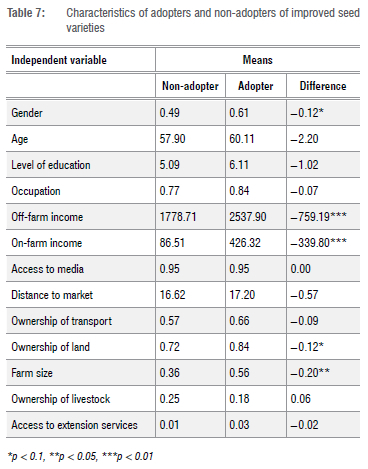
Factors affecting the adoption of improved seed varieties by smallholder farmers
The results estimated using a binary logistic regression model show that age (p < 0.1), off-farm income (p < 0.05), on-farm income (p < 0.01) and ownership of livestock (p < 0.05) are the key explanatory variables that had a substantial effect on the adoption of improved seed varieties by smallholder farmers (Table 8). Only the key factors that had a significant influence on the adoption of improved seed varieties in the study area are briefly discussed in this sub-section.
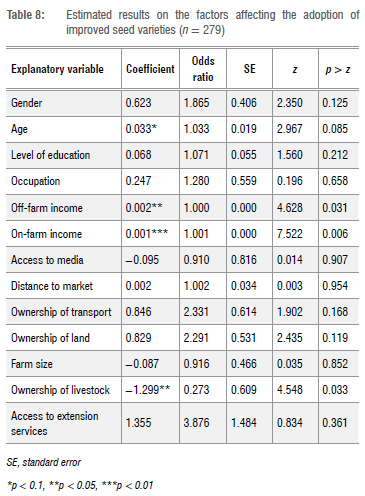
Age
The results indicate a significant positive relationship between the age of the farmer and the probability of adoption of improved seed varieties at a 10% level. They reveal that for a unit increase in age, the odds ratio of a smallholder farmer adopting improved seed varieties is 1.033. The possible explanation for this is that older farmers might be more experienced and some might have worked for commercial farmers and thus been exposed to the different types of improved seed varieties. Furthermore, some of the older farmers could have observed over the years that their traditional seed varieties were becoming more unreliable and gave low yields and thus, they were exploring different coping strategies to meet their production needs. Our findings are in line with previous studies that reported a positive relationship between the age of a farmer and the adoption of improved maize varieties.50,51 However, they differ from other studies that postulate that younger farmers were more likely to adopt improved seed varieties due to their enthusiasm for taking risks and exploring new technologies.17,30
Income
The results indicate that farmers with higher off-farm income were 1.000 times more likely to plant improved seed varieties at a 5% level whilst farmers with higher on-farm income were 1.001 times more likely to plant improved seed varieties at a 1% level. These findings suggest that both off-farm and on-farm income were the key determinants of the adoption of improved seed varieties in the study area. This substantiates the view that access to high income provides farmers with greater powers to purchase improved seed varieties, as also reported by previous studies.36,52
Ownership of livestock
The results indicate that ownership of livestock had a negative and significant effect (-1.299) on the adoption of improved seed varieties at a 5% level. For a unit increase in the ownership of livestock, the odds ratio of a smallholder farmer adopting improved seed varieties is 0.273. This suggests that farmers who owned livestock were more comfortable and likely to feed their livestock with their traditional varieties for which they were more familiar with their characteristics and traits than unknown improved seed varieties with high uncertainties. This indicates that farmers lack information on these new varieties and how different livestock could respond to them. Our findings differ from previous studies that postulate that ownership of livestock had a significant positive effect on the adoption of improved seed varieties.53,54 This could be due to the fact that those studies often associated livestock ownership with wealth and, hence, the purchasing power of inputs. However, most of the farmers in our study area were not selling their livestock but instead keeping them for their own consumption and traditions.
Conclusions and recommendations
This study was undertaken to examine the adoption rate, constraints and factors determining the adoption of improved seed varieties in smallholder farming conditions in the Maluti-a-Phofung municipality of the Free State Province of South Africa, using a maize crop. The results show that most of the smallholder farmers grew uncertified local seed varieties saved from their previous harvest or acquired from neighbouring farmers. The adoption of seed varieties was driven mostly by factors such as easy and stable access, high yield, taste and multi-purpose use. The results also reveal that most of the farmers used improved seed varieties without full knowledge of their specific characteristics, traits and ecological requirements, and how to effectively use them. The major barriers limiting smallholder farmers from adopting the improved seed varieties include lack of awareness and knowledge, inadequate information, unaffordability and unavailability of improved seeds, low income and landlessness. Age and income were the key factors that significantly and positively affected the adoption of improved seed varieties, whilst ownership of livestock had a significant negative effect on their adoption.
Based on the findings, the provision of knowledge and awareness-raising of improved seed varieties through enhanced extension services and capacity-building initiatives are highly recommended to overcome knowledge constraints. This study also encourages the government to improve the existing subsidy programmes and enhance the provision and accessibility of financial resources that are inclusive for smallholder farmers, including women and youth. To improve the availability and affordability of good-quality seed varieties, we recommend that improved seed varieties be sold at a local market in small and affordable micro-packs (2 or 5 kg). The government is also encouraged to improve the infrastructure in remote rural areas to reduce transaction costs for transportation inputs and marketing products. Smallholder farmers are encouraged to work in groups and buy inputs such as improved seeds and fertilisers in bulk at bargain purchasing and transportation costs. We also recommend that community-based seed banks are developed and improved to ensure that the required quantities of locally adapted seeds of good quality are available in remote areas during the planting season and at affordable prices. The recommendations of this study can be used by the government and other developmental organisations to enhance the wider uptake and use of improved seed varieties in smallholder farming conditions and assist farmers to cope effectively with climate variability and change.
Acknowledgements
Knowledge Intelligence Applications GmbH (KIAG) is gratefully acknowledged for the provision of KIPUS software used for data capturing and online storage. We also gratefully acknowledge the Kenya Agricultural & Livestock Research Organisation (KALRO) for the provision of a questionnaire used for primary data collection. Mulalo Thavhana (ARC) is thanked for her technical assistance during the data collection. We acknowledge the Free State Department of Agriculture and Rural Development extension officers and smallholder farmers for their time and their active participation in the household survey as well as the focus group discussions. Dr Thomas Fyfield (ARC) is thanked for his editorial assistance. This research was funded by the European Union's H2020 Research and Innovation Programme, Grant Agreement No. 727201.
Competing interests
We have no competing interests to declare.
Authors' contributions
L.M.: Conceptualisation, methodology, software, validation, formal analysis, writing - original draft preparation, writing - review and editing. M.E.M.: Methodology, writing - review and editing. All authors have read and agreed to the accepted version of the manuscript.
References
1. Acevedo M, Pixley K, Zinyengere N, Meng S, Tufan H, Cichy K, et al. A scoping review of adoption of climate-resilient crops by small-scale producers in low-and middle-income countries. Nat Plants. 2020;6(10):1231-1241. https://doi.org/10.1038/s41477-020-00783-z [ Links ]
2. Tesfahunegn GB, Mekonen K, Tekle A. Farmers' perception on causes, indicators and determinants of climate change in northern Ethiopia: Implication for developing adaptation strategies. Appl Geogr. 2016;73:1-12. https://doi.org/10.1016/j.apgeog.2016.05.009 [ Links ]
3. Vernooy R, Sthapit B, Otieno G, Shrestha P Gupta A. The roles of community seed banks in climate change adaption. Dev Pract. 2017;27(3):316-327. https://doi.org/10.1080/09614524.2017.1294653 [ Links ]
4. Jafino BA, Walsh B, Rozenberg J, Hallegatte S. Revised estimates of the impact of climate change on extreme poverty by 2030. Policy Research Working Paper. Washington DC: World Bank; 2020. p. 17. Available from: https://openknowledge.worldbank.org/entities/publication/a549a5ee-71cd-5ed4-bcf3-3a8cb508b199 [ Links ]
5. Myeni L, Moeletsi M, Thavhana M, Randela M, Mokoena L. Barriers affecting sustainable agricultural productivity of smallholder farmers in the eastern free state of South Africa. Sustainability. 2019;11(11):1-18. https://doi.org/10.3390/su11113003 [ Links ]
6. De Souza K, Kituyi E, Harvey B, Leone M, Murali KS, Ford JD. Vulnerability to climate change in three hot spots in Africa and Asia: Key issues for policy-relevant adaptation and resilience-building research. Reg Environ Change. 2015;15(1):747-753. https://doi.org/10.1007/s10113-015-0755-8 [ Links ]
7. Lunduka RW, Mateva KI, Magorokosho C, Manjeru P Impact of adoption of drought-tolerant maize varieties on total maize production in south Eastern Zimbabwe. Clim Dev. 2019;11(1):35-46. https://doi.org/10.1080/17565529.2017.1372269 [ Links ]
8. Myeni L, Moeletsi ME. Factors determining the adoption of strategies used by smallholder farmers to cope with climate variability in the eastern Free State, South Africa. Agriculture. 2020;10(9):410-426. https://doi.org/10.3390/agriculture10090410 [ Links ]
9. Lipper L, Thornton P Campbell BM, Baedeker T, Braimoh A, Bwalya M, et al. Climate-smart agriculture for food security. Nat Clim Chang. 2014;4(12):1068-1072. https://doi.org/10.1038/nclimate2437 [ Links ]
10. Makate C. Effective scaling of climate smart agriculture innovations in African smallholder agriculture: A review of approaches, policy and institutional strategy needs. Environ Sci Policy. 2019;96(1):37-51. https://doi.org/10.1016/j.envsci.2019.01.014 [ Links ]
11. Amondo E, Simtowe F, Rahut DB, Erenstein O. Productivity and production risk effects of adopting drought-tolerant maize varieties in Zambia. Int J Clim Chang Strateg Manag. 2019;11(4):570-591. https://doi.org/10.1108/IJCCSM-03-2018-0024 [ Links ]
12. Westengen OT, Haug R, Guthiga P, Macharia E. Governing seeds in East Africa in the face of climate change: Assessing political and social outcomes. Front Sustain Food Syst. 2019;3(1):53-67. https://doi.org/10.3389/fsufs.2019.00053 [ Links ]
13. Fajardo Vizcayno J, Hugo W, Sanz Alvarez J. Appropriate seed varieties for small-scale farmers: Key practices for DRR implementers. Rome: FAO; 2014. Available from: https://agris.fao.org/agris-search/search.do?recordID=XF2015001488 [ Links ]
14. Simtowe F, Marenya P, Amondo E, Worku M, Rahut DB, Erenstein O. Heterogeneous seed access and information exposure: Implications for the adoption of drought-tolerant maize varieties in Uganda. Agric Food Econ. 2019;7(1):1-23. https://doi.org/10.1186/s40100-019-0135-7 [ Links ]
15. Dao A, Sanou J, Gracen V Danquah EY Indentifying farmers' preferences and constraints to maize production in two agro-ecological zones in Burkina Faso. Agric Food Secur. 2015;4(1):1-7. https://doi.org/10.1186/s40066-015-0035-3 [ Links ]
16. Ariga J, Mabaya E, Waithaka M, Wanzala-Mlobela M. Can improved agricultural technologies spur a green revolution in Africa? A multicountry analysis of seed and fertilizer delivery systems. Agric Econ (United Kingdom). 2019;50(S1):63-74. https://doi.org/10.1111/agec.12533 [ Links ]
17. Oluwatoyin BC. Factors influencing adoption of improved maize seed varieties among smallholder farmers in Kaduna State, Nigeria. J Agric Ext Rural Dev. 2021;13(2):107-114. https://doi.org/10.5897/JAERD2019.1032 [ Links ]
18. Wossen T, Abdoulaye T, Alene A, Feleke S, Menkir A, Manyong V. Measuring the impacts of adaptation strategies to drought stress: The case of drought tolerant maize varieties. J Environ Manage. 2017;203:106-113. https://doi.org/10.1016/j.jenvman.2017.06.058 [ Links ]
19. Kansiime MK, Mastenbroek A. Enhancing resilience of farmer seed system to climate-induced stresses: Insights from a case study in West Nile region, Uganda. J Rural Stud. 2016;47:220-230. https://doi.org/10.1016/j.jrurstud.2016.08.004 [ Links ]
20. Maity A, Pramanik P. Climate change and seed quality: An alarming issue in crop husbandry. Curr Sci. 2013;105(10):1336-1338. [ Links ]
21. Gidi L, Hlongwane J, Nkoana M. Analysing factors limiting the adoption of improved maize varieties by small-scale maize farmers in Ga-Mamadila Village of Polokwane Municipality, Limpopo. In: Proceedings of the 56th Annual Conference of the Agricultural Economics Association of South Africa (AEASA); 2018 September 25-27; Cape Town, South Africa. Pretoria: AEASA; 2018. https://doi.org/10.22004/ag.econ.284760 [ Links ]
22. Oluwayemisi IA, Olarinde LO, Fatunbi AO. Determinants of adoption of improved maize varieties in Kano-Katsina-Maradi, West Africa. African Crop Sci J. 2017;25(1):1-11. https://doi.org/10.4314/acsj.v25i1.1S [ Links ]
23. Setimela PS, Magorokosho C, Lunduka R, Gasura E, Makumbi D, Tarekegne AT, et al. On-farm yield gains with stress-tolerant maize in eastern and southern Africa. Agron J. 2017;109(2):406-417. https://doi.org/10.2134/agronj2015.0540 [ Links ]
24. Elias SG. The importance of using high quality seeds in agriculture systems. Agric Res Technol Open Access J. 2018;15(4):1-2. https://doi.org/10.19080/ARTOAJ.2018.14.555961 [ Links ]
25. Langyintuo A. Smallholder farmers' access to inputs and finance in Africa. In: Gomez y Paloma S, Riesgo L, Louhichi K, editors. The role of smallholder farms in food and nutrition security. Cham: Springer; 2020. p. 133-152. https://doi.org/10.1007/978-3-030-42148-9_7 [ Links ]
26. Simtowe F, Amondo E, Marenya P, Rahut D, Sonder K, Erenstein O. Impacts of drought-tolerant maize varieties on productivity, risk, and resource use: Evidence from Uganda. Land Use Policy. 2019;88:104091-104101. https://doi.org/10.1016/j.landusepol.2019.104091 [ Links ]
27. Kamau MW, Bagamba F, Riungu C, Mukundi J, Toel R. Early changes in farmers' adoption and use of an improved maize seed: An assessment of the impact of demos and field days. Afr Eval J. 2018;6(1):1-10. https://doi.org/10.4102/aej.v6i1.278 [ Links ]
28. Cacho OJ, Moss J, Thornton PK, Herrero M, Henderson B, Bodirsky BL, et al. The value of climate-resilient seeds for smallholder adaptation in sub-Saharan Africa. Clim Change. 2020;162(3):1213-1229. https://doi.org/10.1007/s10584-020-02817-z [ Links ]
29. Sinyolo S. Technology adoption and household food security among rural households in South Africa: The role of improved maize varieties. Technol Soc. 2020;60:101214-101224. https://doi.org/10.1016/j.techsoc.2019.101214 [ Links ]
30. Toenniessen G, Adesina A, DeVries J. Building an alliance for a green revolution in Africa. Ann N Y Acad Sci. 2008;1136(1):233-242. https://doi.org/10.1196/annals.1425.028 [ Links ]
31. Danso-Abbeam G, Bosiako JA, Ehiakpor DS, Mabe FN. Adoption of improved maize variety among farm households in the northern region of Ghana. Cogent Econ Financ. 2017;5(1):1416896-1416910. https://doi.org/10.1080/23322039.2017.1416896 [ Links ]
32. Cairns JE, Prasanna BM. Developing and deploying climate-resilient maize varieties in the developing world. Curr Opin Plant Biol. 2018;45:226-230. https://doi.org/10.1016/j.pbi.2018.05.004 [ Links ]
33. James M. Low-cost drought and low nitrogen-tolerant maize hybrids for food security in South Africa [webpage on the Internet]. c201 [cited 2023 Jun 08]. Available from: https://www.grainsa.co.za/low-cost-drought-and-low-nitrogen-tolerant-maize-hybrids-for-food-security-in-south-africa [ Links ]
34. Myeni L, Moeletsi ME, Nyagumbo I, Modiselle S, Mokoena L, Kgakatsi IB. Improving the food and nutritional security of smallholder farmers in south africa: Evidence from the InnovAfrica project. Sustainability. 2021;13(17):9902-9913. https://doi.org/10.3390/su13179902 [ Links ]
35. Adenle AA, Wedig K, Azadi H. Sustainable agriculture and food security in Africa: The role of innovative technologies and international organizations. Technol Soc. 2019;58:101143-101160. https://doi.org/10.1016/j.techsoc.2019.05.007 [ Links ]
36. Atube F, Malinga GM, Nyeko M, Okello DM, Alarakol SP Okello-Uma I. Determinants of smallholder farmers' adaptation strategies to the effects of climate change: Evidence from northern Uganda. Agric Food Secur. 2021;10(1):1-14. https://doi.org/10.1186/s40066-020-00279-1 [ Links ]
37. Sigigaba M, Mdoda L, Mditshwa A. Adoption drivers of improved open-pollinated (OPVs) maize varieties by smallholder farmers in the Eastern Cape province of South Africa. Sustainability. 2021;13(24):13644-13718. https://doi.org/10.3390/su132413644 [ Links ]
38. Mutanyagwa Af? Isinika A, Kaliba AR. The factors influencing farmers' choice of improved maize seed varieties in Tanzania. Int J Sci Res Manag. 2018;6(04):55-62. https://doi.org/10.18535/ijsrm/v6i4.ah01 [ Links ]
39. Ngcinela S, Mushunje A, Taruvinga A, Ngarava S, Mutengwa CS. Determinants of genetically modified (GM) maize adoption and the intensity of adoption in OR Tambo District Municipality, Eastern Cape Province, South Africa. GM Crop Food. 2019;10(1):1-11. https://doi.org/10.1080/21645698.2019.1580127 [ Links ]
40. Das B, Deventer FY Wessels A, Mudenda G, Key J, Ristanovic D. Role and challenges of the private seed sector in developing and disseminating climate-smart crop varieties in eastern and southern Africa. In: The Climate-Smart Agriculture Papers. Cham: Springer; 2019. p. 67-78. https://doi.org/10.1007/978-3-319-92798-5_6 [ Links ]
41. Senyolo MP Long TB, Omta O. Enhancing the adoption of climate-smart technologies using public-private partnerships: Lessons from the WEMA case in South Africa. Int Food Agribus Manag Rev. 2021;24(5):755-776. https://doi.org/10.22434/IFAMR2019.0197 [ Links ]
42. Alberts J, Rheeder J, Gelderblom W, Shephard G, Burger HM. Rural subsistence maize farming in South Africa: Risk assessment and intervention models for reduction of exposure to fumonisin mycotoxins. Toxins (Basel). 2019;11(6):334-354. https://doi.org/10.3390/toxins11060334 [ Links ]
43. Mbiriri M, Mukwada G, Manatsa D. Influence of altitude on the spatiotemporal variations of meteorological droughts in mountain regions of the free state Province, South Africa (1960-2013). Adv Meteorol. 2018;2018:1-11. https://doi.org/10.1155/2018/5206151 [ Links ]
44. Moeletsi ME, Walker S. Agroclimatological suitability mapping for dryland maize production in Lesotho. Theor Appl Climatol. 2013;114(1-2):227-236. https://doi.org/10.1007/s00704-012-0829-1 [ Links ]
45. Botai CM, Botai JO, Dlamini LC, Zwane NS, Phaduli E. Characteristics of droughts in South Africa: A case study of Free state and North West provinces. Water (Switzerland). 2016;8(10):439-462. https://doi.org/10.3390/w8100439 [ Links ]
46. Moswetsi G, Fanadzo M, Ncube B. Cropping systems and agronomic management practices in smallholder farms in South Africa: Constraints, challenges and opportunities. J Agron. 2017;16(2):51-64. https://doi.org/10.3923/ja.2017.51.64 [ Links ]
47. InnovAfrica. Innovations in Technology, Institutional and Extension Approaches towards Sustainable Agriculture and Enhanced Food and Nutrition Security in Africa 2017-2018. EU H2020 Grant Support to InnovAfrica Project, Grant Agreement no 727201. Brussels: European Commission; 2016. Available from: https://cordis.europa.eu/project/id/727201 [ Links ]
48. Schroeder C, Onyango TK, Nar RB, Jick NA, Parzies HK, Gemenet DC. Potentials of hybrid maize varieties for small-holder farmers in Kenya: A review based on SWOT analysis. Afr J Food Agric Nutr Dev. 2013;13(2):7562-7586. https://doi.org/10.18697/ajfand.57.11360 [ Links ]
49. Jha S, Kaechele H, Lana M, Amjath-Babu TS, Sieber S. Exploring farmers' perceptions of agricultural technologies: A case study from Tanzania. Sustainability. 2020;12(3):1-21. https://doi.org/10.3390/su12030998 [ Links ]
50. Kaliba AR, Mazvimavi K, Gregory TL, Mgonja FM, Mgonja M. Factors affecting adoption of improved sorghum varieties in Tanzania under information and capital constraints. Agric Food Econ. 2018;6(1):1-21. https://doi.org/10.1186/s40100-018-0114-4 [ Links ]
51. Ademiluyi IO. Adoption of improved maize varieties among farmers in Bassa Local Government Area of Plateau State, Nigeria. Int J Innov Agric Biol Res. 2014;2(4):26-33. [ Links ]
52. Zahidul Islam KM, Sumelius J, Backman S. Do differences in technical efficiency explain the adoption rate of HYV rice? Evidence from Bangladesh. Agric Econ Rev. 2012;13(1):93-110. https://doi.org/10.22004/ag.econ.253500 [ Links ]
53. Sibanda M, Mushunje A, Mutengwa CS. Factors influencing the demand for improved maize open pollinated varieties (OPVs) by smallholder farmers in the Eastern Cape Province, South Africa. J Cereal Oilseeds. 2016;7(2):14-26. https://doi.org/10.5897/JCO2015.0142 [ Links ]
54. Ahmed H, Tetteh Anang B. Impact of improved variety adoption on farm income in Tolon District of Ghana. Agric Soc Econ J. 2019;19(2):105-115. https://doi.org/10.21776/ub.agrise.2019.019.2.5 [ Links ]
55. Siyum N, Giziew A, Abebe A. Factors influencing adoption of improved bread wheat technologies in Ethiopia: Empirical evidence from Meket district. Heliyon. 2022;8(2):1-11. https://doi.org/10.1016/j.heliyon.2022.e08876 [ Links ]
 Correspondence:
Correspondence:
Lindumusa Myeni
Email: MyeniL@arc.agric.za
Received: 18 Oct. 2022
Revised: 08 June 2023
Accepted: 09 June 2023
Published: 28 Sep. 2023
Editor: Teresa Coutinho
Funding: Horizon 2020 Framework Programme (727201)














